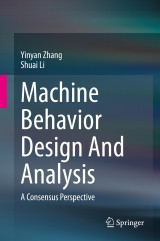Details

Machine Behavior Design And Analysis
A Consensus Perspective|
CHF 118.00 |
|
| Verlag: | Springer |
| Format: | |
| Veröffentl.: | 13.03.2020 |
| ISBN/EAN: | 9789811532313 |
| Sprache: | englisch |
Dieses eBook enthält ein Wasserzeichen.
Beschreibungen
<p></p><p>In this book, we present our systematic investigations into consensus in multi-agent systems. We show the design and analysis of various types of consensus protocols from a multi-agent perspective with a focus on min-consensus and its variants. We also discuss second-order and high-order min-consensus. A very interesting topic regarding the link between consensus and path planning is also included. We show that a biased min-consensus protocol can lead to the path planning phenomenon, which means that the complexity of shortest path planning can emerge from a perturbed version of min-consensus protocol, which as a case study may encourage researchers in the field of distributed control to rethink the nature of complexity and the distance between control and intelligence. We also illustrate the design and analysis of consensus protocols for nonlinear multi-agent systems derived from an optimal control formulation, which do not require solving a Hamilton-Jacobi-Bellman (HJB) equation.</p>
<p>The book was written in a self-contained format. For each consensus protocol, the performance is verified through simulative examples and analyzed via mathematical derivations, using tools like graph theory and modern control theory. The book’s goal is to provide not only theoretical contributions but also explore underlying intuitions from a methodological perspective.</p><br><p></p>
<p>The book was written in a self-contained format. For each consensus protocol, the performance is verified through simulative examples and analyzed via mathematical derivations, using tools like graph theory and modern control theory. The book’s goal is to provide not only theoretical contributions but also explore underlying intuitions from a methodological perspective.</p><br><p></p>
<p></p><p>Chapter 1: Introduction to Collective Machine Behavior.- Chapter 2: Second-Order Min-Consensus.- Chapter 3: Consensus of High-Order Discrete-Time Multi-Agent Systems.- Chapter 4: Continuous-Time Biased Min-Consensus.- Chapter 5: Discrete-Time Biased Min-Consensus.- Chapter 6: Biased Consensus Based Distributed Neural Network.- Chapter 7: Predictive Suboptimal Consensus.- Chapter 8: Adaptive Near-Optimal Consensus.</p><p></p>
<p><b>Yinyan Zhang </b>received his B.E. degree from Sun Yat-sen University, Guangzhou, China and Ph.D. degree from the Hong Kong Polytechnic University, Hong Kong SAR, China. He was a Postdoctoral Fellow with the Department of Computing, Hong Kong Polytechnic University. Currently, he is a Professor with the College of Cyber Security, Jinan University, Guangzhou, China. His main research interests include multi-agent systems, intelligent control, robotics, and security and control of cyber-physical systems. He has published more than 40 scientific papers as an author or co-author, including 20 IEEE transaction papers.</p><p> <b>Shuai Li</b> received his B.E. degree in Precision Mechanical Engineering from Hefei University of Technology, China in 2005, his M.E. degree in Automatic Control Engineering from the University of Science and Technology of China in 2008, and his Ph.D. in Electrical and Computer Engineering from the Stevens Institute of Technology, USA in 2014. He iscurrently affiliated with the School of Engineering, Swansea University, UK. His main research interests include neural networks, robotics, control of networked systems, computation and optimization. He has been working on the research and application of neural networks/dynamics for more than 10 years, and has published more than 100 scientific papers. In addition, he is now serving as an associate editor of the International Journal of Advanced Robotic Systems, Frontiers in Neurorobotics, Neural Processing Letters, and Journal of Rehabilitation Robotics, and as an editorial board member for the International Journal of Distributed Sensor Networks and Neural Computation & Applications.<br></p>
<p></p><p>In this book, we present our systematic investigations into consensus in multi-agent systems. We show the design and analysis of various types of consensus protocols from a multi-agent perspective with a focus on min-consensus and its variants. We also discuss second-order and high-order min-consensus. A very interesting topic regarding the link between consensus and path planning is also included. We show that a biased min-consensus protocol can lead to the path planning phenomenon, which means that the complexity of shortest path planning can emerge from a perturbed version of min-consensus protocol, which as a case study may encourage researchers in the field of distributed control to rethink the nature of complexity and the distance between control and intelligence. We also illustrate the design and analysis of consensus protocols for nonlinear multi-agent systems derived from an optimal control formulation, which do not require solving a Hamilton-Jacobi-Bellman (HJB) equation.</p>
<p>The book was written in a self-contained format. For each consensus protocol, the performance is verified through simulative examples and analyzed via mathematical derivations, using tools like graph theory and modern control theory. The book’s goal is to provide not only theoretical contributions but also explore underlying intuitions from a methodological perspective.</p><p></p>
<p>The book was written in a self-contained format. For each consensus protocol, the performance is verified through simulative examples and analyzed via mathematical derivations, using tools like graph theory and modern control theory. The book’s goal is to provide not only theoretical contributions but also explore underlying intuitions from a methodological perspective.</p><p></p>
The first book focusing on min-consensus and relevant issues for multi-agent systems Includes both theoretical analyses of the models and simulative examples of various consensus protocols Convenient and suitable for undergraduate or postgraduate students as well as academic and industrial researchers from the fields of distributed computing, distributed control, consensus, and path planning

















